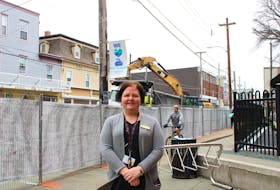The RCMP searched computers, phones, a GPS and the in-car data of two vehicles in its probe of last month’s Nova Scotia mass shooting in a bid to learn how much advanced planning the gunman did before setting off on his rampage.
New information outlining steps taken by the RCMP in the wake of the worst mass killing in Canada’s history is revealed in police documents from the ongoing investigation, released Monday on a judge’s order.
The documents were prepared by the RCMP to get the court’s approval to search various properties and to compel other people to assist police in their probe. Heavily redacted versions of the documents were ordered released as part of a court motion by media organizations.
The in-car data was sought for two vehicles recovered by police, a 2013 Ford Taurus and a 2015 Mercedes. A company called Berkshire Broman Corporation, registered by Wortman in New Brunswick, owned the Ford and the Mercedes was registered in Wortman’s own name. A witness said Wortman’s common-law spouse usually drove the Mercedes.
Police were interested in retrieving the “stored data” from the cars that might show if he traced his deadly path ahead of time. In-car data systems are computers in the vehicle used to control audio, navigation and other features.
The results of the data search are not yet known.
“Gabriel Wortman went on a killing spree that covered in excess of 50 kilometres and the navigation track logs could provide information whether Gabriel traveled this route prior to April 18, 2020,” one RCMP document says.
Wortman, 51, had other cars — including a replica RCMP cruiser he used during his attacks — but he set them on fire.
He was dressed in an authentic RCMP uniform and drove a replica RCMP cruiser when he set off on a terrifying murder rampage across northern Nova Scotia, from the evening of April 18 to midday April 19.
He killed 22 people, police said.
Two months before the killings, Wortman was stopped by police and charged with speeding while driving the Ford Taurus on Portapique Beach Rd., the rural road into a community of properties, including some of Wortman’s, the documents say.
Police also sought court permission to search electronic equipment found by officers, including a Samsung cellphone, a laptop, a memory card, a tablet and a GPS.
Among the information still withheld from the public in this version of released documents is who owned some of the devices, and what police believed they would find on them. Although what was found on the devices is not revealed, the documents do show there were no insurmountable password or security access difficulties, as has happened in other mass murder investigations.
One of the newly released documents is information filed by police with a justice of the peace to authorize a production order, which is a court order for someone who is not the suspect of the crime to turn over specific information. The warrant is for Telus Communications, a cell phone service based in Toronto, to release phone records.
Wortman’s spouse likely owned the phone in question, as she told police he didn’t have a cell phone of his own and an email sent from Wortman to an acquaintance suggests he sometimes used his spouse’s phone for people to contact him.
Properties
Warrants to search the gunman’s properties was also issued to allow police to look for “firearms, ammunition, explosives, chemicals” and a final item that was censored. Investigators were also looking for human remains, police-related clothing, identification and equipment and “documents related to planning mass murder events.”
Wortman burned down the buildings on his properties in Portapique at the start of his murder spree by dousing them with gasoline, the documents say. Evidence of the destruction is revealed in the documents.
At his property at 200 Portapique Beach Rd., police found an ammunition box containing a burnt $100 bill; a burnt receipt book; burnt parts of a gun; a black plastic bag and another ammunition box, the details of which are redacted.
At his property at 136 Orchard Beach Dr., police found “rounds,” presumably a reference to ammunition, but the details have been redacted.
Police seized nothing from his property at 287 Portapique Beach Rd.
Officers also searched his other properties in other communities, including his two denture clinics, which were not burned.
It was at his property on Portland St., in Dartmouth, N.S., that police found the two cars and the electronic equipment, including a laptop computer, a tablet device, a router (which connects computers to a modem for accessing the internet), and a small SD card (a data storage device often used in cameras). Police did not find or seize anything relating to their investigation at his Halifax clinic.
The six documents released Monday repeat the basic narrative of the killings and summaries of harrowing witness interviews included in a document released last week , with the same redactions.
“Gabriel Wortman showed a complete disregard for human life as he shot at people sitting in their cars, people walking on the side of the road, and at people in their private homes,” one of the documents says, summarizing the vast crime being investigated.
“Witness statement were obtained and Gabriel Wortman was described as a man who collected firearms, decommissioned police cars, police uniforms and equipment, was paranoid and had security systems in place at his properties.”
Killings
The investigation into the killings is ongoing. The gunman knew some of his victims while others were random people he encountered, police said.
His first victims were those close to his home in Portapique, about 135 kilometres north of Halifax. He was shot and killed by police when he stopped for gas in Enfield, N.S.
A single document, called an Information to Obtain (ITO), was released by the court last week. Crown prosecutors described it as the most comprehensive overview of the investigation up to the point it was written, April 24.
The other documents released Monday include additional ITOs for search warrants, police reports to justices of the peace detailing the results of their searches, and production orders, which are court orders to compel others to assist police.
There are at least 20 such ITOs from the police investigation being sought by a consortium of media organizations, including Postmedia.
Future court hearings are scheduled to examine the reasons why portions of the ITOs are redacted, and to potentially argue over how necessary the redactions are. The reasons for the redactions will not be known until June 12.
The media’s court challenge to access the documents is to ensure transparency and public scrutiny over an important investigation, amid growing calls for a public inquiry into the incident.
Case law says search warrant information — once executed and if items are seized by police — should be public information.
Crown prosecutors, however, argue that some information involving third parties, victims, and information that could hamper an ongoing investigation, needs to be withheld from the public.
Copyright Postmedia Network Inc., 2020








